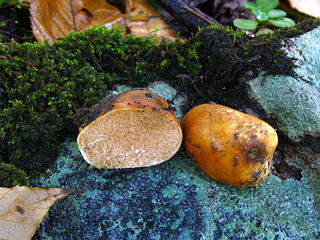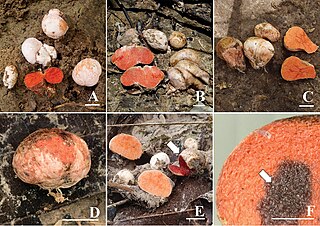Related Research Articles

The Boletaceae are a family of mushroom-forming fungi, primarily characterised by small pores on the spore-bearing hymenial surface, instead of gills as are found in most agarics. Nearly as widely distributed as the agarics, the family is renowned for hosting some prime edible species highly sought after by mushroom hunters worldwide, such as the cep or king bolete . A number of rare or threatened species are also present in the family, that have become the focus of increasing conservation concerns. As a whole, the typical members of the family are commonly known as boletes.

Claussenomyces is a genus of fungi in the family Helotiaceae. Species grow as saprophytes on decaying and decorticated wood, cones, or sap. Fruitbodies are turbinate to pulvinate, measuring up to 0.6 mm in both height and diameter. The flesh has an elastic to gelatinous texture.
Royoungia is a fungal genus in the family Boletaceae. This genus is represented by the type species Royoungia boletoides, which was found in Australia. In 2016, 5 more species were found in China.

Polyozellus is a fungal genus in the family Thelephoraceae, a grouping of mushrooms known collectively as the leathery earthfans. Previously considered a monotypic genus, it now contains the Polyozellus multiplex species complex. The genus name is derived from the Greek poly meaning many, and oz, meaning branch. It is commonly known as the blue chanterelle, the clustered blue chanterelle, or, in Alaska, the black chanterelle. The distinctive fruit body of this species comprises blue- to purple-colored clusters of vase- or spoon-shaped caps with veiny wrinkles on the undersurface that run down the length of the stem.
Gigasperma is an inactive genus of fungi in the order Agaricales with a single species. It was treated either as the only genus in the monotypic family Gigaspermataceae, or part of the wider Cortinariaceae. Gigasperma was circumscribed by Austrian mycologist Egon Horak in 1971.
Horakiella is a genus of fungi within the Sclerodermataceae family that contains the two species H.clelandii and H. watarrkana.

Pisolithus is a genus of fungi within the family Sclerodermataceae. The type species, P. arenarius, is now known to be synonymous with P. arhizus.

Descolea is a genus of fungi in the family Bolbitiaceae. Described by mycologist Rolf Singer in 1952, the widespread genus contains about 15 species. It was formerly placed in the family Cortinariaceae because of its limoniform basidiospores and its ectomycorrhizal lifestyle. A 2013 molecular phylogenetics study by Tóth et al. found it to be closely related to the genus Pholiotina The genus Pseudodescolea, erected for the single Descolea-like species Pseudodescolea lepiotiformis, was formerly considered distinct until a 1990 study found it to be a synonym of Descolea antarctica.

Zelleromyces is a genus of fungi in the family Russulaceae. It was first described by mycologists Rolf Singer and Alexander H. Smith in 1960 to contain hypogeous (underground) fungi with gasteroid fruit bodies that "bleed" latex when they are cut.

Austropaxillus is a genus of fungi in the family Serpulaceae, containing nine species found in Australia, New Zealand and South America.

Trappea is a genus of truffle-like fungi in the Trappeaceae family. Species of Trappea have been found in China, Europe, and North America.

Octaviania is a genus of truffle-like fungi in the family Boletaceae. The widespread genus is estimated to contain 15 species.

Rhodactina is a genus of secotioid fungi in the family Boletaceae. The genus was circumscribed in 1989 based on the type species Rhodactina himalayensis, found in India and northern Thailand. The genus was originally classified in the family Gauteriaceae because of similarities in spore ornamentation to the genera Gautieria and Austrogautieria. A second species, Rhodactina incarnata, was added to the genus in 2006. It is found in Dipterocarpaceae-dominated forests in Chiang Mai. Molecular phylogenetics analysis shows that Rhodactina is aligned with the Boletaceae.
Reddellomyces is a genus of truffle-like fungi in the Tuberaceae family. The genus, circumscribed in 1992, contains four species found in Australasia and the Mediterranean.
Andebbia is a fungal genus in the family Mesophelliaceae. The genus is monotypic, containing the single truffle-like species Andebbia pachythrix, found in Australia.
Malajczukia is a genus of truffle-like fungi in the Mesophelliaceae family. The genus contains eight species found in Australia and New Zealand.
Fischerula is a genus of two truffle-like fungi in the family Morchellaceae. First described from central Italy by Oreste Mattirolo in 1928, the genus name honors Swiss mycologist Eduard Fischer. The type species Fischerula macrospora is known only from Italy, while Fischerula subcaulis is found in coniferous and mixed forests of Oregon and Washington.

Endogone is a genus of fungi in the family Endogonaceae of the division Zygomycota. The genus has a widespread distribution, especially in temperate regions, and contains about 20 species.

Harrya is a fungal genus in the family Boletaceae. It was circumscribed in 2012 to contain the species Harrya atriceps and the type Harrya chromapes.
James Martin Trappe is a mycologist and expert in the field of North American truffle species. He has authored or co-authored 450 scientific papers and written three books on the subject. MycoBank lists him as either author or co-author of 401 individual species, and over the course of his career he has helped guide research on mycorrhizal fungi, and reshaped truffle taxonomy: establishing a new order, two new families, and 40 individual genera.
References
- ↑ Lumyong S, Sanmee R, Lumyong P, Yang ZL, Trappe JM (2003). "Mycoamaranthus cambodgensis comb. nov., a widely distributed sequestrate basidiomycete from Australia and southeastern Asia". Mycological Progress. 2 (4): 323–5. doi:10.1007/s11557-006-0069-9.
- ↑ Kirk PM, Cannon PF, Minter DW, Stalpers JA (2008). Dictionary of the Fungi (10th ed.). Wallingford, UK: CAB International. p. 447. ISBN 978-0-85199-826-8.
- ↑ Burkhardt, Lotte (2022). Eine Enzyklopädie zu eponymischen Pflanzennamen [Encyclopedia of eponymic plant names](pdf) (in German). Berlin: Botanic Garden and Botanical Museum, Freie Universität Berlin. doi:10.3372/epolist2022. ISBN 978-3-946292-41-8 . Retrieved January 27, 2022.
- ↑ "Mycoamaranthus - Search Page". www.speciesfungorum.org. Species Fungorum. Retrieved 27 December 2022.